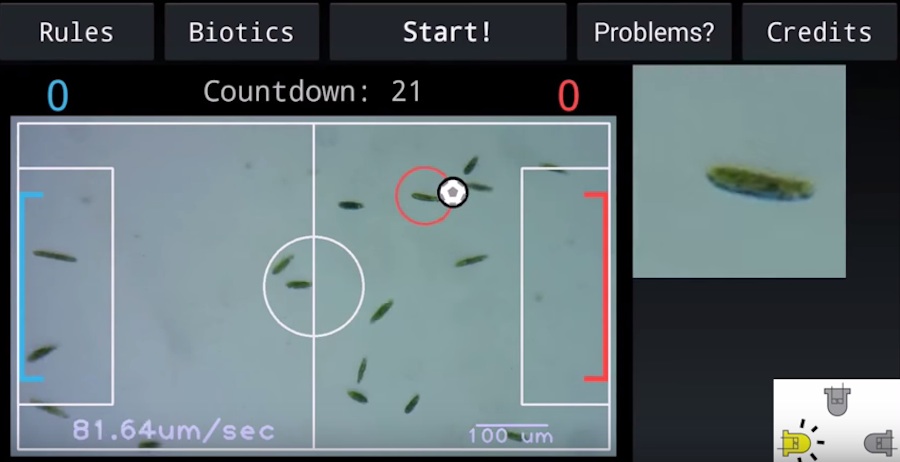
A 3D-printed smartphone microscope system is making microbiology interactive by allowing schoolkids to experiment and play games with light-seeking microbes.
The so-called LudusScope borrows its name from the Latin word "ludus," which means "play," "game" or "elementary school." The device looks similar to a standard microscope, but can be docked with a smartphone and features LED lights controlled with a joystick. Students use these to influence the swimming direction of Euglena microbes, which exhibit characteristics of both plants and animals because they feed like animals but photosynthesize like plants.
A companion smartphone app allows kids to track individual microbes by tapping on them on the screen. Features like scale bars, speed readings and grid overlays help users take measurements of things they see in the field of view. The app also comes with games that let students track microbes while attempting to guide them around a "Pac-Man"-style maze or use them to score goals on a simulated soccer pitch. [Gift Ideas for Kids: Best Educational Toys & Games]
The idea is the brainchild of Ingmar Riedel-Kruse, an assistant professor of bioengineering at Stanford University, whose lab is developing ways to make bioscience education more interactive and engaging.
"The most important thing I think you can do as a teacher or parent is inspire. Get them excited — that's almost more important than the actual content delivery," he told Live Science.
Riedel-Kruse said one of his major inspirations was video games, which came about because electronics and computers became powerful enough to simulate things. With the ability to manipulate biological systems now reaching similar levels, the team decided to explore using microorganisms to design games and other media.
With the LudusScope, the designer wanted a device that not only helped kids learn formal science skills in a more interactive way, but also helped them learn by playing and learn by building, Riedel-Kruse said. The DIY nature of the system means it teaches things like optics, fabrication, electronics and programming, he said.
Sign up for the Live Science daily newsletter now
Get the world’s most fascinating discoveries delivered straight to your inbox.
The project also took cues from the field of robotics, he added.
"You learn a lot about construction, mechanical things like gear wheels and also programming," Riedel-Kruse said. "Especially in the life sciences, we don't yet have these cool tools or toys that you have more in the physical sciences and mechatronic fields. That's something we want to address, and we hope inspire other people to do as well."
Schools can print the frame themselves or get third-party providers to make it for them. The optical system consists of a closed-circuit TV camera lens and a standard 10x-magnification eyepiece, which allows students to look directly through the microscope instead if they wish.
Acrylic slides and coverslips are fixed together using double-sided tape to make chambers for the Euglena, with an inlet and outlet in each chamber. The sample holder features four LEDS pointing in toward the center of the sample and an analog joystick that controls which LEDs light up.
The designs are open-source, and the entire setup should cost roughly $100, the researchers said, or around $60 for schools that have their own 3D printers. Riedel-Kruse's lab has also received a seed grant to collaborate with an educational game company to develop a ready-made kit for purchase.
"This was really about how can we make something low cost and also as accessible as possible," Riedel-Kruse said. [The Best Coding Toys for Kids]
To incorporate lessons on programming, the team built a simple biophysical model using the kid-friendly coding language Scratch. The model features virtual microbes with similar behavior to the Euglena, but students can adjust parameters like swimming speed and light sensitivity to explore how those changes affect the model or try to fit the model to their own observations. This teaches lessons in both programming and the importance of models in scientific research, Riedel-Kruse said.
After touring science fairs with the device, the team invited teachers and students to their lab to try out the technology and give feedback. The researchers said they were surprised to find that for teachers, some of the simpler elements of the system were the most attractive. "For example, just the fact that you have a screen attached to your microscope so everyone can look at the same thing at the same time," Riedel-Kruse said.
The device fits well with school curriculums from 6th grade right up to high school, he said, but being open-source, it can also be adapted for more advanced teaching.
"The idea is it's an easy entry point, but you could go very complex in many ways," Riedel-Kruse added. "All the way to an extreme level where the teachers say, 'Let's build a similar device, but let's use a different organism or put [in] colored LEDS to see how the cells respond to not only the light intensity but also the different colors."
Original article on Live Science.












